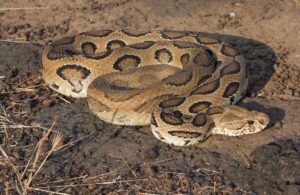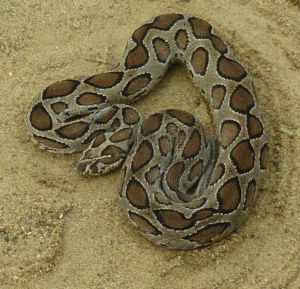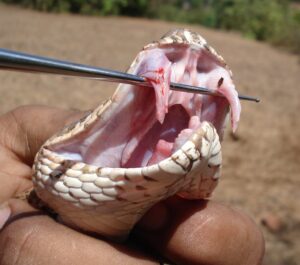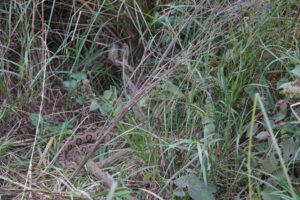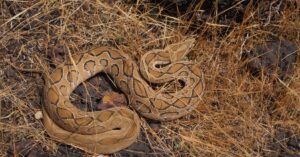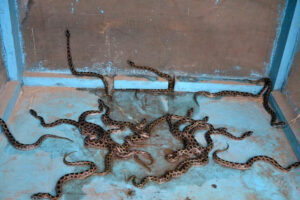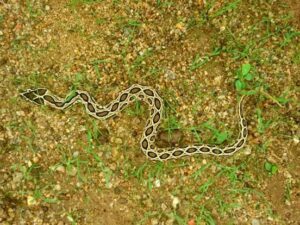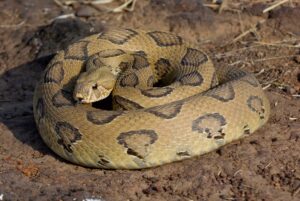Russell’s viper, also known as chain viper, Indian Russell’s viper, common Russell’s viper, chain snake, seven pacer, and scissors snake, is among India’s four most common venomous snakes, the other three being the spectacled cobra, saw-scaled viper, and common krait. It is called “Chandraborha” in Bengali because it has lunar shaped marks all over its body.
It is named after Patrick Russell because he wrote about it in his 1796 work, “An Account of Indian Serpents, collected on the Coast of Coromandel.” The name of its genus comes from a Hindi word meaning “the lurker” or “that lies hid.”
These solitary and terrestrial snakes are primarily nocturnal foragers, but they alter their behavior in winter and become active during the day. They are found in places frequently visited by humans.
Though a heat-sensitive organ is yet to be identified, the fact that they react to thermal cues indicates the possession of one. While the identity of the sensors is not certain, the nerve endings in the supranasal sac seem to resemble heat-sensitive organs in other snakes.
Scientific Classifications
- Suborder:Serpentes
- Family:Viperidae
- Genus:Daboia
- Species:D.russelii
Conservation Status
Subspecies
This snake has four recognized subspecies:
- D.s.formosensis
- D.s.limitis
- D.r.pulchella
- D.r.nordicus
Description
Size
In mainland Asia, Russell’s viper reaches an average length of 47 inches (120 cm). The maximum length recorded is 65 inches (166 cm).
Color and Appearance
The body color of Russell’s viper is a deep yellow, tan, or brown. It has three series of dark brown spots that cover its entire body. The spots are outlined with a black ring, and the ring’s outline is highlighted with a white or yellow rim.
Their heads are flat, triangular, and distinct from the neck. They have large nostrils at the center of a large, single nasal scale. The lower part of the nasal scale is connected with the nasorostral scale, and the supranasal scale separates the two anteriorly. The rostral scale is broad and high. Their eyes are big and have a touch of gold or yellow. 10-15 circumorbital scales surround the eyes. 3-4 rows of suboculars separate the eye from 10-12 supralabials. They have two pairs of chin shields, of which the front pair is larger. Their supraocular scales are thin, single, and separated by 6-9 scales across the head.
These snakes have stout bodies, and their cross-section is rounded to circular, but they tend to be leaner than most vipers. They have rough dorsal scales, of which the lowest row is smoother. Their mid-body has 27-33 dorsal scales, and their underside has 153-180 ventral scales. Their tail is only 14% of the total body weight with 41-68 pairs of subcaudals.
Its head has two prominent dark patches, one on each temple, and a pinkish, salmon, or brownish “V” or “X” marking forming an apex towards the snout. A dark streak behind the eye has a pink, white, or buff outline. It has a whitish, yellowish, or pinkish abdomen, often with dark spots scattered irregularly.
Are They Dangerous to Humans
Russell’s vipers are dangerous to humans because their bite can inject lethal venom into the human body. The venom is injected through their teeth. The adult specimens are reported to yield venom of 130-250 mg, 150-250 mg, and 21-268 mg. Their median lethal dose in mice is 0.133mg/kg intravenous, 0.40 mg/kg intraperitoneal, and 0.75 mg/kg subcutaneously.
However, the toxicity of the venom depends on a combination of five different venom fractions. Each of them is less toxic when separately tested. The toxicity also varies within diverse populations and changes over time.
After being bitten by this snake, the person feels pain at the bite site (lasting 2–4 weeks), followed by swelling of the affected area. Other symptoms include bleeding from the gums and with urine, dropping heart rate and low blood pressure, and blistering at the bite site.
Facial swelling, vomiting, and kidney failure are observed in one-third of the cases. Death might happen due to septicemia or cardiac, kidney, or respiratory failure within 1–14 days after the bite. Early medical treatment and timely access to antivenom can minimize the chances of dying.
These vipers are often found in urban areas or near the countryside, where they come in search of food. Because of this, people who live in these areas and work outdoors are more at risk of being bitten.
However, they are mainly docile and reluctant to bite but tend to attack if stepped on too hard.
Russell’s Viper at a Glance
Distribution
These snakes are found in Asian countries like India, Bangladesh, Pakistan, Nepal, Sri Lanka, Myanmar, Tibet, China, Cambodia, Taiwan, Thailand, and Indonesia.
In northern India, they mainly occur along the west coast and the hills of Punjab. In southern India, they are found in Karnataka and in eastern India, they occur north of Bengal. They are rarely found in the Ganges valley, northern Bengal, and Assam.
Habitat
Russell’s vipers prefer plains and coastal lowlands. They tend to avoid altitudes, but sometimes, they are seen as far up as 7500-9800 feet (2300-3000 m). They are rarely found in dense forests and mostly live in open, grassy, bushy areas, forested plantations, scrub jungles, and farmlands. They also avoid humid regions such as swamps, marshes, and rainforests. Sometimes they can be found in urbanized areas due to the occurrence of rodents attracted to human activities.
Lifespan
They can live up to 15 years.
Predators
The common predators of Russell’s viper are birds of prey and mongooses.
When threatened, they form several S-shaped loops and raise one-third of their body to produce a hiss louder than any other snake. While striking, they exert such a force that even a large viper can lift most of its body off the ground.
Diet
Russell’s vipers are ambush predators who remain still until they attack, relying on their camouflage to stay hidden. They feed primarily on rodents but sometimes eat land crabs, scorpions, small reptiles, and other arthropods. Juveniles eat lizards and even display cannibalistic behavior, but as they grow older, they switch to rodents like their adult counterparts. The presence of lizards and rodents is why these snakes are often found in human habitations.
They have long, hypodermic, needle-like, hinged fangs in front of their mouth, with the help of which they can inject venom easily with just a jab. They don’t have to cling to their prey.
Reproduction
They are ovoviviparous, with females giving live birth to young ones. Their mating season starts in April and lasts till July.
The gestation period is over six months. Mainly they are prolific breeders capable of producing 20-40 young in a single litter but sometimes give birth to only one snakelet. The hatchlings are born starting from May all the way to November, but most births take place throughout June and July.
The newborns are 8.5-10.2 in (215-260 mm) in total length and become independent after birth. They reach reproductive maturity when they are 2-3 years old.
Similar Species
Old World Sand Boa
These are non-venomous snakes whose color pattern is similar to that of Russell’s viper.
Russell’s Boa
These snakes mimic Russell’s vipers but are entirely harmless.
Care Sheet
Size of Enclosure: Russell’s vipers are terrestrial snakes, and it is challenging to keep them in captivity. They require a lot of space to live in. Their enclosure should be at least 4 X 2 X 2 ft.
Substrate: As these snakes are terrestrial, a soily substrate should be used. A suitable substrate for them is an artificial termite mound made of plastic.
Humidity: The humidity level of the enclosure should be 70 – 80%.
Temperature: The temperature of the enclosure should be maintained between 28⁰C and 31⁰C.
Lighting: Enough sunlight should enter the enclosure as they acquire vitamins from exposed sunlight. If sunlight cannot enter the chamber, a heated pot or a 25-watt bulb should be kept in the enclosure.
Feeding: They are given rodents and lab rats to eat in captivity.
Source
rahulalvares.com, googleapis.com, rahulalvares.com, rajasthanbiodiversity.org, cloudinary.com, rahulalvares.com

